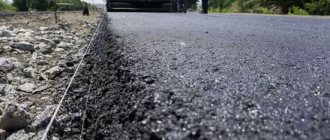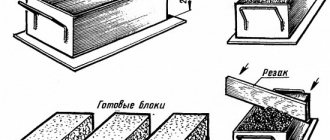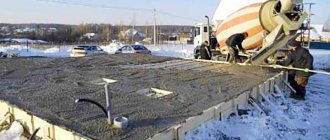However, often a concrete base is used instead. It is asphalt on a concrete base that has the highest strength characteristics, long service life and resistance to various types of natural influences. Laying the asphalt itself in this case, of course, happens last.
Before you begin laying asphalt, you must complete all preliminary and preparatory work. These include site preparation and soil stabilization. Laying asphalt is not as easy a process as it might seem. To carry it out, certain knowledge, skills and abilities are required.
Schematic representation of layers when laying asphalt.
At the stage of preparatory work, documents and GOSTs are also studied. Moreover, for the correct and high-quality laying of asphalt, it is necessary to pay close attention to the standardization of the CMEA.
This document describes the requirements and characteristics of public roads. If these requirements are not taken into account, the laid asphalt pavement will not last long - it will quickly crack and become uneven.
Technological standards
Asphalt laying technology
The technology for laying asphalt is set out in SNiPs, collections of technical and legal regulations containing a detailed description of the work process and control methods.
Accurate adherence to the recommendations of SNiP allows you to create road surfaces that can withstand the loads of vehicles, changes in humidity and temperature for a long time.
Asphalt laying technology
The technology of the method separates the laying:
- for the preparatory stage;
- laying the supporting layer (sand, crushed stone);
- application of road surfaces (coarse bitumen KZ-7, KZ-10);
- roller compaction.
To eliminate defects that appear after completion of work, cold asphalt is used, which has a different structure and resistance to low temperatures. A distinctive feature of the product is its plasticity, which allows the use of cold bitumen for patching work and in areas adjacent to the reinforced concrete sheet.
Applying asphalt to asphalt
Many people are interested in the question of whether it is possible to lay asphalt on old asphalt?
The complexity of the technological process of laying a road surface on old asphalt depends on the level of wear of the road surface. GOST allows patching repair of local damage using cold bitumen.
Cold bitumen is one of the components for road patching
For large-scale work, road companies use the cold or hot milling method, which involves:
- removal of the top layer;
- texturing;
- laying a fresh layer.
According to accepted GOST standards, road work must be carried out in dry weather, taking into account humidity and air temperature.
Technical requirements
The technological process of laying defense asphalt is not as simple as it might seem at first glance. Such work requires skills, experience and knowledge. Before you begin laying or repairing the road surface, you need to study the necessary manuals, documents, instructions, and GOSTs. The following are only the main GOSTs:
- GOST 7473-85. This document describes the necessary rules, requirements and technical nuances. It is these standards that must be taken as a starting point during the production of concrete solutions.
- GOST 9128-97. This document provides requirements for different types of concrete solutions used for highways and airfields.
- GOST 28013-89. This document provides requirements for the production of asphalt concrete solutions.
- GOST 30412-96. This document describes methods and materials for accurately measuring slope and roughness angles for public roads and airfields.
- GOST 30413-96. This document was written directly for public roads; it describes a method for finding the indicator of adhesion between the wheels of cars and the road surface.
However, you need to study not only the above manuals, but also pay attention to the standardization of CMEA . It specifies the general requirements and parameters of public roads. If you do not comply with the requirements specified in the documentation, then this risks the fact that the installed coating will soon become covered with cracks, and unevenness will appear on the surface.
Asphalt restoration
When overhauling roads, a technological technique is used - “restoration” of the road surface. The procedure consists of:
- from cleaning the old coating with a watering machine;
- laying crushed stone with a grader;
- cleaning and heating the edges of the coating;
- laying and compacting the fresh layer with a roller.
The final stage of work is impregnation of seams and joints with bitumen.
If the road surface is in acceptable condition and wear is uniform, repair companies also “build up” the road surface by laying fresh asphalt on top of the cleaned old layer.
Is it possible to lay asphalt in the rain?
Why do doubts arise?
Reasons why laying over existing asphalt is not advisable:
- Asphalt pavement is a waterproof material. Water entering through the cracks between the tiles collects in the space under the tiles. At sub-zero temperatures, it freezes, expands and undermines the tile, making it look like a pile of bricks. This problem is common with paving stones laid over intact asphalt.
- Cracks and holes in old canvas become overgrown with moss and grass over time. Various debris accumulates in them. On such a basis it is impossible to compact the bedding layer tightly. In addition, the road plants will rot, creating voids under the pavers, causing them to sag. Usually, before laying a new surface, the damaged asphalt layer is completely removed.
- The need to raise the level of the platform, curbs or neck of the storm drain. In places where the path or platform adjoins the entrances to buildings, as well as if there are swing gates on the territory, there may be difficulties with opening doors (gates).
Typically, specialists inspect the area, pointing out these technical issues. Before laying the paving stones, the old layer can be completely removed or left if it is still intact. If the old base remains, then before the new laying, it is necessary to provide holes for drainage in the asphalt. This is done with a hammer drill and a long drill 15-20 mm thick. The asphalt surface must be drilled right through to the bedding. The holes should be a mesh with a cell size of 10-20 cm.
Laying asphalt on concrete
Laying asphalt on a concrete base involves using concrete as a substitute for crushed stone mixture. Roads of this type are characterized by strength and reliability.
The advantages of asphalt concrete include:
- load resistance;
- non-slip, smooth surface;
- contact and reliable grip with car tires.
In addition, a concrete-based coating is convenient for applying durable road markings.
Preliminary stage
The main pouring process is preceded by a number of preparatory works:
- cleaning and compacting the soil;
- strengthening the top layer of soil.
The initial stage includes: removing vegetation and compacting the soil with a one and a half ton roller. At the end of the work, the prepared area should present a flat surface, with an error in the angle of inclination of no more than 3 cm per 3 m of area.
The next stage is treating the soil with sterilizing solutions that destroy the root system of plants and prevent the germination of grass.
A mandatory procedure prior to pouring concrete is laying drainage. It is recommended to lay drainage made from crushed stone and quarry sand under concrete in alternating layers, at least 10 cm wide. Then, the drainage is compacted and spilled with water until the desired level of shrinkage and density is obtained.
Materials for paving on concrete basis
Asphalt concrete is the result of mixing types of bitumen with the addition of sand, gravel, and crushed stone. The mixture is prepared in ovens at a certain temperature and appropriate pressure.
Asphalt concrete mixtures are marked by grain level.
Comparative table of asphalt concrete mixtures
To increase contact, activating solutions are added to the resulting product, and modifying additives are added to increase strength.
In addition to classification by grain level, asphalt concrete is distinguished by laying temperature.
There are two types of installation:
- cold, above 50 °C;
- hot, from 100 °C.
Based on the volume of internal voids, laid asphalt concrete is divided into highly porous, porous and dense.
Materials required to create the coating
The construction market presents a large assortment. You can easily buy a solution that perfectly strengthens the soil, which gives durability and strength to the coating. The road surface can be used for a long period. Distinguished by its special composition, the adhesive mass connects soil particles, giving the soil strength and making it similar to stone.
Before pouring concrete mixture onto the soil, it is recommended to perform certain actions:
- The surface layer of soil is cleared of vegetation and compacted with rollers whose mass exceeds one and a half thousand kilograms. The result should be a flat surface, the slope of which will not exceed three centimeters for the next three-meter segment of length.
- The soil surface should be treated with sterilizing compounds to prevent the germination of vegetation.
- Before laying concrete, a drainage layer is installed using crushed stone and sand. There are several similar layers, each with a thickness of one hundred millimeters. The drainage pad compacts well; it is recommended to shed the surface to improve shrinkage.
The sand is compacted almost ninety percent.
To lay asphalt on a concrete base, you need to mix different grades of bitumen, sand, crushed stone and gravel. The kneading is carried out under the influence of elevated temperatures and strong pressure, in ovens specially designed for such types of work. The finished mixture is divided into brands based on the size of the grains. To improve contact and increase the adhesive qualities of organic and inorganic compounds included in asphalt concrete, the technological process provides for the addition of special activation mixtures. But improving the strength and resistance value is achieved by introducing additional modifiers.
In addition to the grain size values, asphalt concrete differs in the temperature regime of laying. There are two types:
- cold – from 50 degrees or more;
- hot – at least 150.
Depending on the size of the voids in asphalt, the coating can be:
Laying technology
The main condition for a high-quality coating is the continuity of the process and carrying out work in the shortest possible time, therefore a continuous supply of asphalt mass to the road surface is important.
Continuous supply of asphalt mass is one of the important factors for a job well done
The second condition is compliance with the temperature regime of the mixture. Thus, according to GOST, the bitumen mixture should not cool below 105 °C.
Processing of laid asphalt during large-scale road construction works is carried out using rollers and auto pavers.
Laying paving slabs on asphalt
When laying paving slabs, a common question is: can paving slabs be laid on asphalt, and what to do with the remnants of the old base, since dismantling is a labor-intensive and time-consuming process?
According to most experts, it is necessary to remove the remnants of the old coating. It is believed that this approach saves the roadway from subsidence and destruction.
Technologies for laying tiles on asphalt are used in the construction of pedestrian paths, or in the courtyards of private houses, where the load on the road is minimal.
Technology for laying paving slabs on an asphalt base
Maintenance of asphalt concrete pavement
In order for the canvas to last as long as possible, you need to adhere to a number of rules regarding care. You should not allow massive equipment, especially tracked ones, to drive over the newly laid surface.
If this is neglected, the resulting dents will cause the destruction of the coating, which will have to be repaired or re-laid. This restriction especially applies to the operation of the roadway in the summer season. This is explained by the fact that in hot weather the asphalt pavement softens more and is subject to deformation.
Tile laying technology
To lay paving slabs on asphalt you will need:
- sand (river);
- dry cement mixture;
- water.
Tools you will need: a rule and a rake.
Before laying tiles (paving stones), you should prepare the area:
- Pour, level and compact a 5–10 cm layer of sand.
- Lay a mixture of cement and sand (3:1), at least 5 cm thick and moisten with water.
Laying tiles on the old road surface, in compliance with technological standards, will save time and will allow you to use the old surface as a fastening agent, which in the future will improve the operational capabilities of the road.
Laying and compaction procedure
It is important to carry out the technological process associated with laying asphalt road surfaces according to the instructions. As soon as the concrete solution is delivered or prepared, it is necessary to immediately begin the coating and it is advisable to lay it all at once. Delay is not acceptable; this requirement is one of the main ones in all GOSTs.
If there is a large volume of work to be done, for example, the development of public roads, then it is advisable to use special installation equipment - auto pavers and rollers. However, if the work to be done is small, for example, arranging a sidewalk, then you can get by with mops and shovels. In addition, it is not always possible to compact coatings with even a small roller. In such a situation, the best solution would be to use vibrating plates.
If you plan to carry out the work on your personal yard or dacha, then most likely you will not use the services of special designers. However, this does not mean that you should not follow certain standards for coverage widths. Depending on the type of coating, this indicator varies:
- for paths in the garden, the layer width should be approximately 4 centimeters;
- for driveways, the width should be at least 5 centimeters.
The quality of installation of foundations and concrete depends on the correct execution of technological processes. It is important that the base is done on time and thoroughly compacted. Compaction can be performed using several technologies - using vibration, using a roller and using manual compaction. Specialized techniques may also vary. It could be:
- automated roller;
- manual roller;
- vibrating roller;
- vibrating plate.
According to the requirements specified in GOST 9128-2009, the temperature regime for laying the concrete mixture should not be less than 100C. This temperature ensures better compaction of the formed coating. After all, the lower the temperature in the concrete solution, the harder it is to compact it, and as a result, longer work with the roller will be required. In order to prevent the mixture from sticking to the vibrating plate or other equipment, you must first water them with water.
To ensure that the coating surface is equally smooth, it is necessary to carefully monitor the number of passes of the roller. This number must be the same. To prevent damage to the concrete coating, the roller should not perform reverse movements. If the stages of the technological process are carried out carefully, then asphalting the road surface will not be at all difficult.











